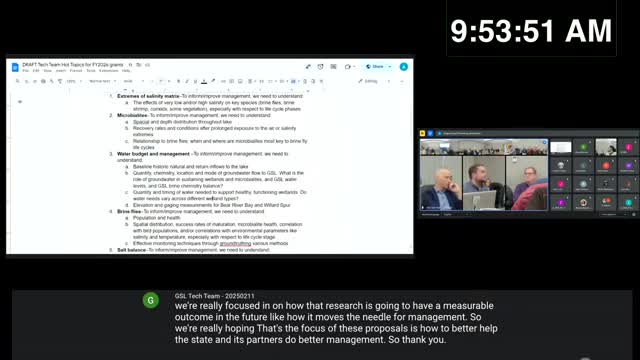State explores water budget improvements amid conservation and import water discussions
December 09, 2024 | Utah Great Salt Lake Advisory Council, Boards and Commissions, Organizations, Utah Executive Branch, Utah
This article was created by AI summarizing key points discussed. AI makes mistakes, so for full details and context, please refer to the video of the full meeting. Please report any errors so we can fix them. Report an error »

The Great Salt Lake Advisory Council is ramping up efforts to enhance water management strategies, with a focus on improving data collection and monitoring inflows to the lake. During a recent meeting, council members highlighted the critical need for better technology to track water sources and inflows, which are essential for effective water budget management.
A key discussion point was the lack of baseline data regarding inflows to the Great Salt Lake. Council members expressed concern that without accurate measurements, it is challenging to assess the impact of conservation efforts and potential water imports. "We don't have that baseline inflow data that we really need," one member noted, emphasizing the importance of understanding how much water is naturally entering the lake.
The council is considering proposals for new research that could fill these data gaps. They encouraged stakeholders to identify areas where additional studies could provide valuable insights, particularly in monitoring rainfall and inflow rates. "Look for gaps in data that aren't being covered," another member urged, pointing out that existing meteorological stations are insufficient, especially around the North Arm of the lake.
The council is also moving forward with plans to release a request for proposals (RFP) soon, aiming to gather meaningful proposals for research and technology improvements. They hope to finalize the RFP within the next week or two, allowing ample time for stakeholders to contribute their ideas.
As the Great Salt Lake faces ongoing environmental challenges, these discussions underscore the urgency of developing a comprehensive water management strategy that leverages technology and data to safeguard this vital resource.
A key discussion point was the lack of baseline data regarding inflows to the Great Salt Lake. Council members expressed concern that without accurate measurements, it is challenging to assess the impact of conservation efforts and potential water imports. "We don't have that baseline inflow data that we really need," one member noted, emphasizing the importance of understanding how much water is naturally entering the lake.
The council is considering proposals for new research that could fill these data gaps. They encouraged stakeholders to identify areas where additional studies could provide valuable insights, particularly in monitoring rainfall and inflow rates. "Look for gaps in data that aren't being covered," another member urged, pointing out that existing meteorological stations are insufficient, especially around the North Arm of the lake.
The council is also moving forward with plans to release a request for proposals (RFP) soon, aiming to gather meaningful proposals for research and technology improvements. They hope to finalize the RFP within the next week or two, allowing ample time for stakeholders to contribute their ideas.
As the Great Salt Lake faces ongoing environmental challenges, these discussions underscore the urgency of developing a comprehensive water management strategy that leverages technology and data to safeguard this vital resource.
View full meeting
This article is based on a recent meeting—watch the full video and explore the complete transcript for deeper insights into the discussion.
View full meeting

